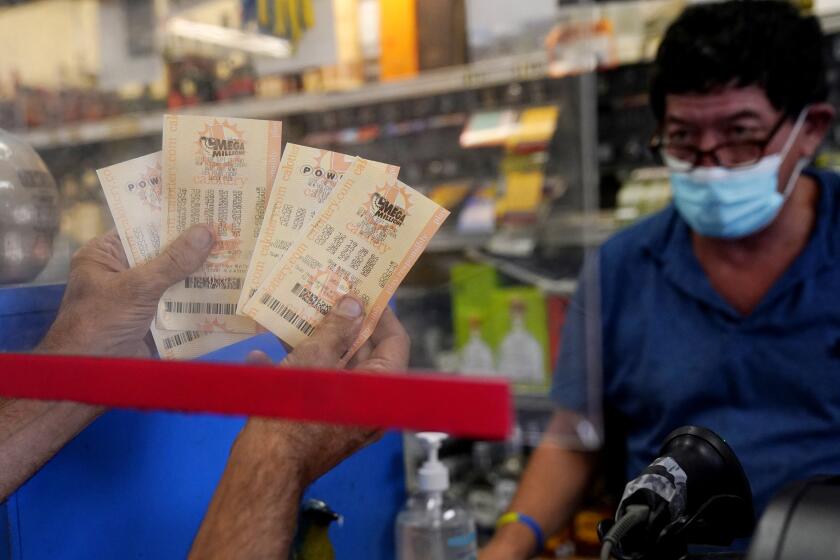Specialty Crops Are the Growing Thing
- Share via
The choice for the San Diego County farmer is to adapt, to migrate or to perish. Mike Horwath decided to adapt.
The Escondido farmer found a crop or two where he had an edge--a year-round growing season--and began to produce products with no local competition.
His 15 acres of artichokes and 33 acres of rhubarb mature before growers to the north can hit the market, and after growers in Mexico have finished their season.
Far Cry From Earlier Days
Horwath’s small plots of specialty crops in the San Pasqual Valley are a far cry from the 1,200 acres or so his family farmed on Otay Mesa or the 1,100 acres they have leased since 1978 in the city of San Diego’s agricultural preserve in the San Pasqual Valley. In April, Horwath will be moving on, unable to grow traditional crops on the city land because of escalating lease prices.
Gone are the days when land was cheap and oat hay, tomatoes, corn and other row crops could be grown for profit. Land leases have skyrocketed as farmers have had to compete with developers and with each other for the remaining relatively flat land in the county.
Slowly, growers are being pushed back from the coastal slopes, where crops are guaranteed a year-round growing season, to the backcountry around Ramona, Valley Center and Escondido, where a killer frost is always a possibility.
So Horwath teamed up last year with the University of California Agricultural Extension Division to introduce artichokes as a specialty crop in San Diego County, and he plans to continue to “fine tune” his operation--planting and harvesting cycles--to reap the most benefit from off-season market prices. It will take another year or so before he finds the exact planting dates that will assure that his crop comes in before the competition’s starts.
Specialty farming is nothing new in San Diego County, according to Wayne Schrader, a county farm adviser. And growers for years have been taking advantage of the mild temperatures to raise agricultural crops that mature during the off-season.
“We call them ‘windows of opportunity,’ when the crops from the south, Mexico mostly, have finished and before the crops to the north come in,” Schrader said.
A Profitable Few Acres
Add to that the growing of unusual crops that bring high prices because of their rarity, and farmers can reap as much from a few acres as they once did from hundreds, he said.
Strawberries were once an off-season crop, Schrader said, but many growers have moved south into Mexico, producing strawberries earlier and with cheaper labor and fewer controls on pesticides.
Schrader calls Horwath a “progressive” and an “early innovator” in introducing new high-yield crops to the county. The farm adviser feels Horwath is paving the path to a new kind of agriculture in the county that will flourish when row crops and hay succumb to bulldozers and condominiums.
Horwath began to market his artichokes this month at the Pacific Beach Farmers Market, where his rhubarb has been selling well since last fall.
The rhubarb plants were hit by a December chill and are still recovering. The artichokes show burns from the unseasonable frost but keep on growing.
These specialty crops, Horwath said, “are the trend of the future” for San Diego County agriculture.
Plump and Thornless
Making use of the county’s long growing season to harvest during off-season periods and marketing specialty products directly and locally are his adaptation methods.
Horwath’s son Jason, a senior at San Pasqual High School in Escondido, handles the Saturday marketing chores.
The rhubarb brings a dollar a pound premium price, and is particularly popular with the younger shoppers at the farmers market, at Garnet Avenue and Mission Boulevard. The artichokes, plump and thornless, bring 75 cents to $1 each.
Horwath realizes that he can’t compete with nursery-stock growers in bidding for the city land leases in San Pasqual, so he’s scouting for other land in the area where he can grow his specialty crops and a few more traditional ones.
He would eventually like to expand his rhubarb fields to 100 acres, but is wary of outgrowing the demand. A couple of hundred acres of off-season artichokes should satisfy the local market and then some, he said.
More to Read
Sign up for Essential California
The most important California stories and recommendations in your inbox every morning.
You may occasionally receive promotional content from the Los Angeles Times.













